The Influence of an Unsupported Sleeper on the Vertical Bearing Characteristics of Heavy-Haul Railway Ballast
Abstract
:1. Introduction
2. Discrete Element Modeling
2.1. Discrete Element Model of Railway Ballast
2.2. Verification of Ballast Model
3. Bearing Characteristics of Ballast Bed with an Unsupported Area
3.1. Distribution of Contact Force
3.2. Influence of Unsupported Length on Vertical Bearing Stiffness
3.3. Influence of Unsupported Width on Vertical Bearing Stiffness
3.4. Influence of Unsupported Height on Vertical Bearing Stiffness
3.5. Influence of Unsupported Position on Vertical Bearing Stiffness
4. Influence of an Unsupported Sleeper on Wheel/Rail Interaction
4.1. Vehicle/Track Coupling Dynamics Model
4.2. Vertical Wheel/Rail Force
- (1)
- Influence of Unsupported Length
- (2)
- Influence of Unsupported Height
4.3. Sleeper Supporting Force
- (1)
- Influence of Unsupported Length
- (2)
- Influence of Unsupported Height
5. Conclusions
- (1)
- For the unsupported sleeper, although the ballast particles beneath the unsupported area do not have direct contact with the sleeper, except for the topmost particles, a significant portion of them actively contribute to bearing the vertical force transmitted from the sleeper. Consequently, conventional nonlinear spring models are deemed inadequate for simulating unsupported sleepers.
- (2)
- An unsupported sleeper will reduce both the supporting area of the ballast bed under the sleeper, and the number of ballast particles, thus increasing the contact force between the particles and accelerating the deterioration of ballast particles.
- (3)
- When the vertical load is less than 5 kN, there is little influence from the unsupported length on the vertical displacement. As the unsupported length increases, as does the vertical bearing stiffness of the ballast bed decreases accordingly. For an unsupported length of 800 mm, the vertical bearing stiffness is 139.23 kN/mm, representing a decrease of 19.8% compared to the intact ballast bed.
- (4)
- When the vertical load is less than 7.5 kN, the vertical displacement of the sleeper basically remains the same for different unsupported widths. As the unsupported width increases, the vertical bearing stiffness of the ballast bed gradually decreases. When the sleeper is completely unsupported in the width direction, the vertical bearing stiffness of the ballast bed decreases from 173.63 kN/mm (that of an intact ballast bed) to 141.46 kN/mm, representing a decrease of 18.5%.
- (5)
- When the unsupported height is less than 15 mm, there is little influence on the vertical bearing stiffness of the ballast bed. In the range of 20~50 mm, the vertical bearing stiffness of the ballast bed is significantly reduced compared with that for the intact ballast but does not vary as height increases within this range. When the height exceeds 50 mm, the vertical bearing stiffness decreases significantly as height increases. When the height is increased from 50 mm to 55 mm, it decreases from 153.79 kN/mm to 134.23 kN/mm, a reduction of 12.8%.
- (6)
- Different unsupported positions also have different influences on the vertical bearing stiffness of the ballast bed: when the sleeper ends are unsupported and the unsupported distance is greater than 500 mm, the vertical bearing stiffness of the ballast bed remains relatively small.
- (7)
- When a single sleeper is unsupported, even though an increase in the unsupported length and height will cause a corresponding increase in longitudinal wheel/rail force to different extents, the actual change is very small. Therefore, a single unsupported sleeper has limited influence on wheel/rail interactions.
- (8)
- An increase in unsupported length and height will lead to a decrease in the sleeper supporting force exerted on the unsupported position and to an increase in the supporting force exerted by the sleepers on the left and right sides of the unsupported sleeper. However, a partially unsupported sleeper at one end has little influence on the overall sleeper supporting force, and the associated change in amplitude remains small. When a single sleeper is completely unsupported, the sleeper supporting force will change significantly, which will, in turn, accelerate the deterioration of the ballast bed.
Author Contributions
Funding
Institutional Review Board Statement
Informed Consent Statement
Data Availability Statement
Conflicts of Interest
References
- Lu, Z. Railway Track Structure and Maintenance; China Railway Publishing House: Beijing, China, 2002. [Google Scholar]
- Liu, H.; Xiao, J.; Chen, M.; Chen, R.; Wang, P. Experimental Study on Resistance of Granular Ballast Bed under Periodic Longitudinal Load. J. China Railw. Soc. 2017, 39, 104–111. [Google Scholar]
- Olsson, E.L.; Zack RIsson, P. Long-Term Measurement Results, Final Report; Technical Report; Banverket: Borlänge, Sweden, 2002. [Google Scholar]
- Ishida, M.; Moto, T.; Kono, A.; Jin, Y. Influence of loose sleeper on track dynamics and bending fatigue of rail welds. Q. Rep. RTRI 1999, 40, 80–85. [Google Scholar] [CrossRef]
- Auguetin, S.; Gudehus, G.; Huber, G.; Schünemann, A. Numerical Model and Laboratory Tests on Settlement of Ballast Track; Springer: Berlin, Germany, 2003. [Google Scholar]
- Kim, K.J.; Lee, S.J.; Jang, S.Y.; Hwang, S.H. Evaluation of the influence factors on the ballast settlement by using the discrete element method. J. Korean Soc. Civ. Eng. 2016, 36, 715–722. [Google Scholar]
- Kaewunruen, S.; Remennikov, A.M. Investigation of free vibrations of voided concrete sleepers in railway track system. Proc. Inst. Mech. Eng. Part F J. Rail Rapid Transit 2007, 221, 495. [Google Scholar] [CrossRef]
- Grassie, S.L. Dynamic modeling of concrete railway sleepers. J. Sound Vib. 1995, 187, 799. [Google Scholar] [CrossRef]
- Xiang, J.; Yang, H.; He, D. Research on the Responses of Vertical Vibration of Train-Track System due to Voided Sleeper. J. Railw. Sci. Eng. 2007, 4, 8–12. [Google Scholar]
- Xiao, X.; Jin, X.; Wen, Z. Effect of Track Support Failure on Dynamic Response of Tangent Track. Chin. J. Theor. Appl. Mech. 2008, 40, 67–78. [Google Scholar]
- Zhang, J.; Wu, C.; Xiao, X.; Wen, Z.; Jin, X. Effect of Unsupported Sleepers on Sleeper Dynamic Performance Response. J. Southwest Jiaotong Univ. 2010, 45, 203–208. [Google Scholar]
- Xiao, X.; Jin, X.; Wen, Z. Effect of disabled fastening systems and ballast on vehicle derailment. J. Vib. Acoust. 2007, 129, 217–229. [Google Scholar] [CrossRef]
- Zhang, S.; Xiao, X.; Wen, Z.; Jin, X. Effect of unsupported sleepers on wheel/rail normal load. Soil Dyn. Earthq. Eng. 2008, 28, 662–673. [Google Scholar] [CrossRef]
- Zhang, D.; Wang, K.; Zhai, W.; Liu, P. Effect of Unsupported Sleepers on the Wheel/Rail Interaction of Heavy-Haul Railway lines. J. Vib. Shock. 2017, 36, 1–7. [Google Scholar]
- Wei, Z.; Liu, B.; Yang, F.; Zhou, Y.; Li, L.; Li, G. Influence of Unsupported Sleeper on Wheel-Rail Contact at Rail Weld Irregularity. J. Tongji Univ. (Nat. Sci. Ed.) 2021, 49, 517–525. [Google Scholar]
- Zhou, H.; Bao, Z.; Zhang, S. Dynamic Evolution Process of Voided Sleeper. J. Univ. Stat. (Nat. Sci. Ed.) 2019, 47, 521–527. [Google Scholar]
- Zakeri, J.A.; Fattahi, M.; Ghanimoghadam, M.M. Influence of unsupported and partially supported sleepers on dynamic responses of train–track interaction. J. Mech. Sci. Technol. 2015, 29, 2289–2295. [Google Scholar] [CrossRef]
- Mosayebi, S.-A.; Zakeri, J.A.; Esmaeili, M. Effects of train bogie patterns on the mechanical performance of ballasted railway tracks with unsupported sleepers. Proc. Inst. Mech. Eng. Part F J. Rail Rapid Transit 2018, 232, 238–248. [Google Scholar] [CrossRef]
- Cui, X.; Xiao, H.; Xiao, H.; Ma, C. DEM Analysis of Effect of Unsupported Sleepers on Dynamic Characteristics of Ballast Beds. J. Vib. Shock. 2020, 39, 171–179. [Google Scholar]
- Zhang, X.; Zhao, C.; Zhai, W.; Feng, Y. Discrete element simulation and its validation on vibration and deformation of railway ballast. Rocks Soil Mech. 2017, 5, 1481–1488. [Google Scholar]
- Huang, H.; Chrismer, S. Discrete element modeling of ballast settlement under trains moving at “Critical Speeds”. Constr. Build. Mater. 2013, 38, 994–1000. [Google Scholar] [CrossRef]
- Huang, H.; Tutumluer, E. Image-Aided Element Shape Generation Method in Discrete-Element Modeling for Railroad Ballast. J. Mater. Civ. Eng. 2013, 26, 527–535. [Google Scholar] [CrossRef]
- Saussine, G.; Cholet, C.; Gautier, P.E.; Dubois, F.; Bohatier, C.; Moreau, J.J. Modelling ballast behaviour under dynamic loading. Part 1: A 2D polygonal discrete element method approach. Comput. Methods Appl. Mech. Eng. 2005, 195, 2841–2859. [Google Scholar] [CrossRef]
- Jing, G.; Qiang, W.; Chang, J.; Li, X. Effect of flakiness-elongation index on shear behavior of railway ballast. J. Southwest Jiaotong Univ. 2020, 55, 688–694. [Google Scholar]
- Cui, X.; Ma, Z.; Jin, F. The effect of rail corrugation on dynamic characteristics of heavy haul railway ballast bed. J. Huazhong Univ. Sci. Technol. Nat. Sci. 2021, 49, 110–115. [Google Scholar]
- TB/T 2140-2008; Railway Ballast. Ministry of Railways of the People’s Republic of China: Beijing, China, 2008.
- TB10625-2017; Code for Design of Heavy Haul Railway. National Railway Adminsistration of the People’s Republic of China: Beijing, China, 2017.
- TB 10082-2017; Code for Design of Raiway Track. National Railway Adminsistration of the People’s Republic of China: Beijing, China, 2017.
- Han, H. Research on under Ballast Mats: Mesoscopic Contact Behavior and Influence on Mechanical Properties of the Ballast Bed. Master’s Thesis, China Academy of Railway Sciences Corporation Limited, Beijing, China, 2023. [Google Scholar]
- Zhai, W.; Wang, K. Lateral Hunting Stability of Railway Vehicles Running on Elastic Track Structures. J. Comput. Nonlinear Dyn. 2010, 5, 041009. [Google Scholar] [CrossRef]
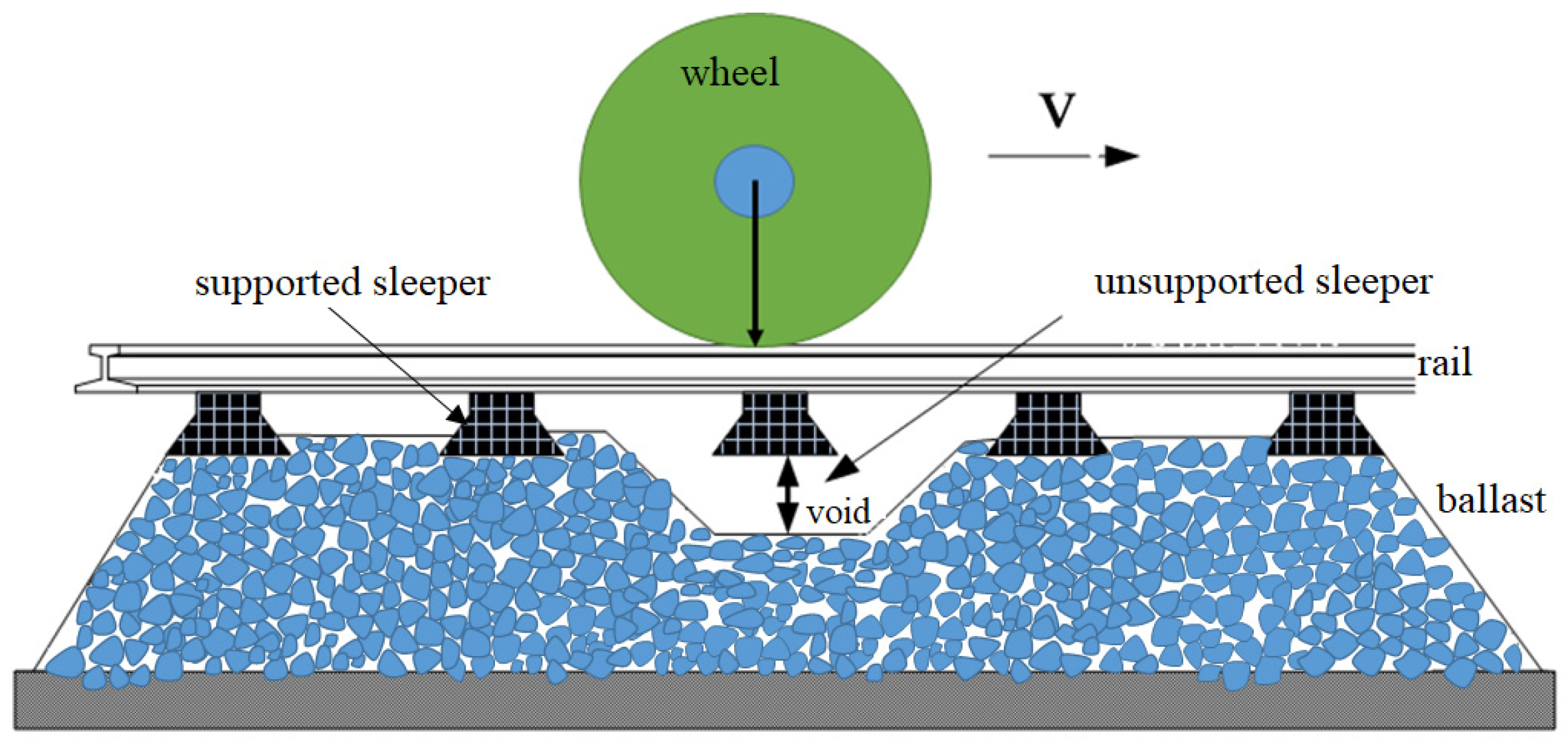


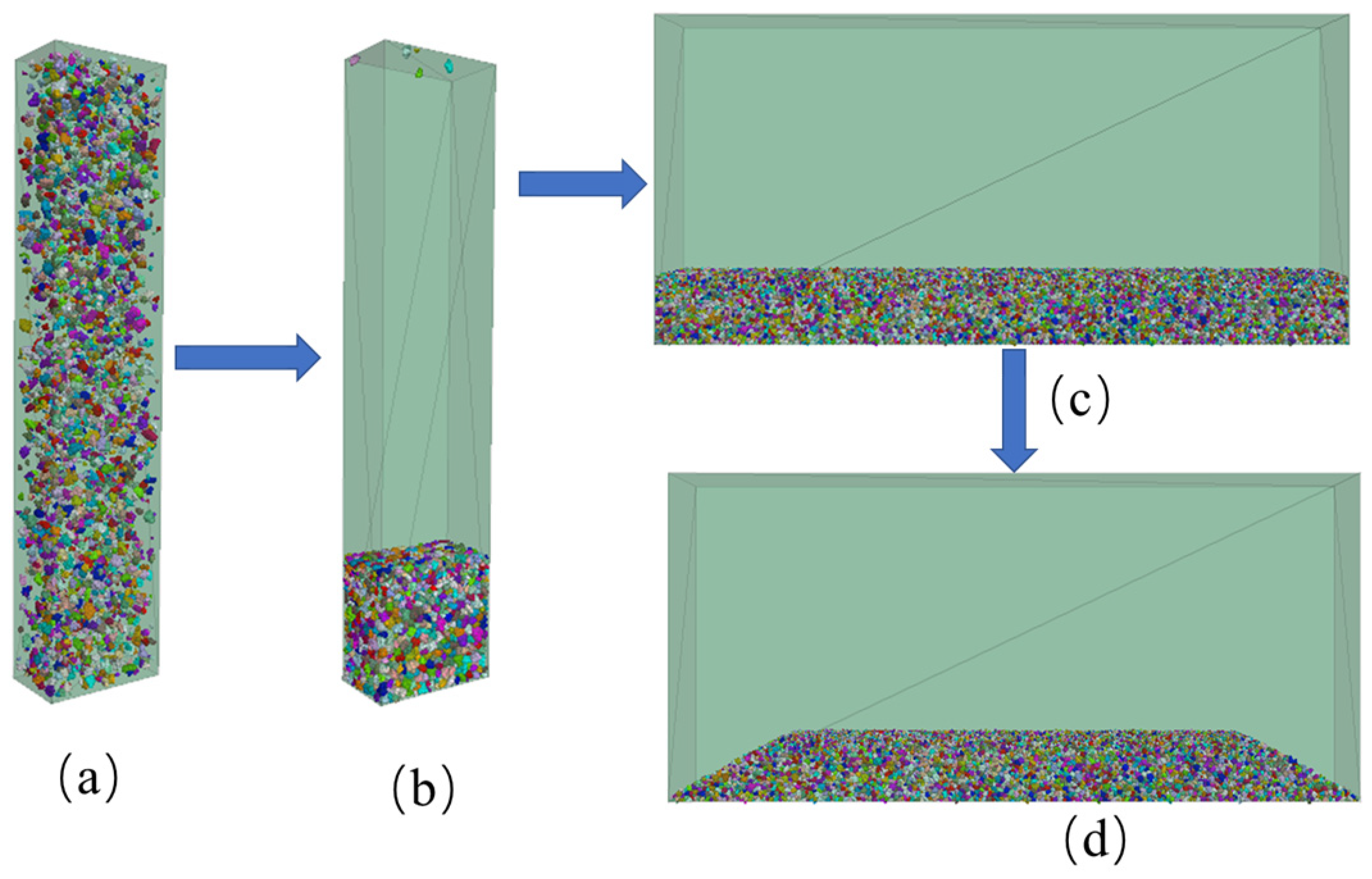



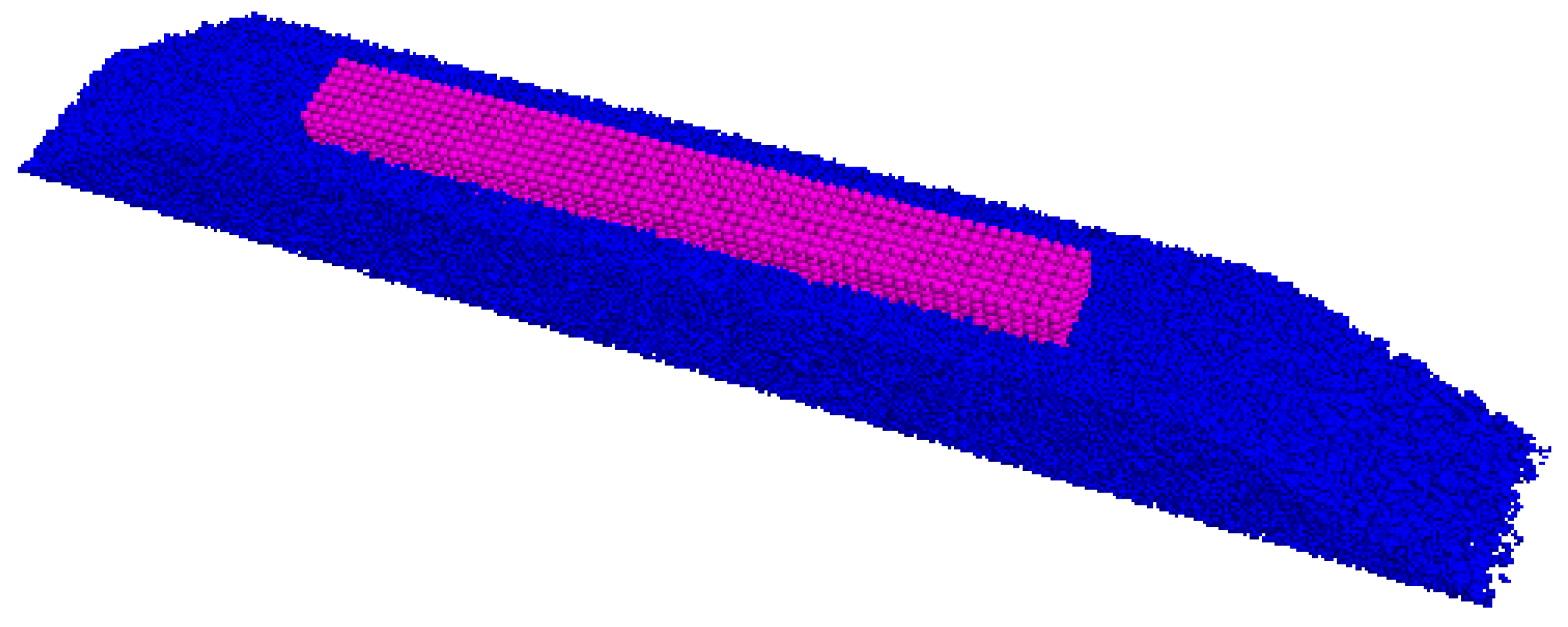
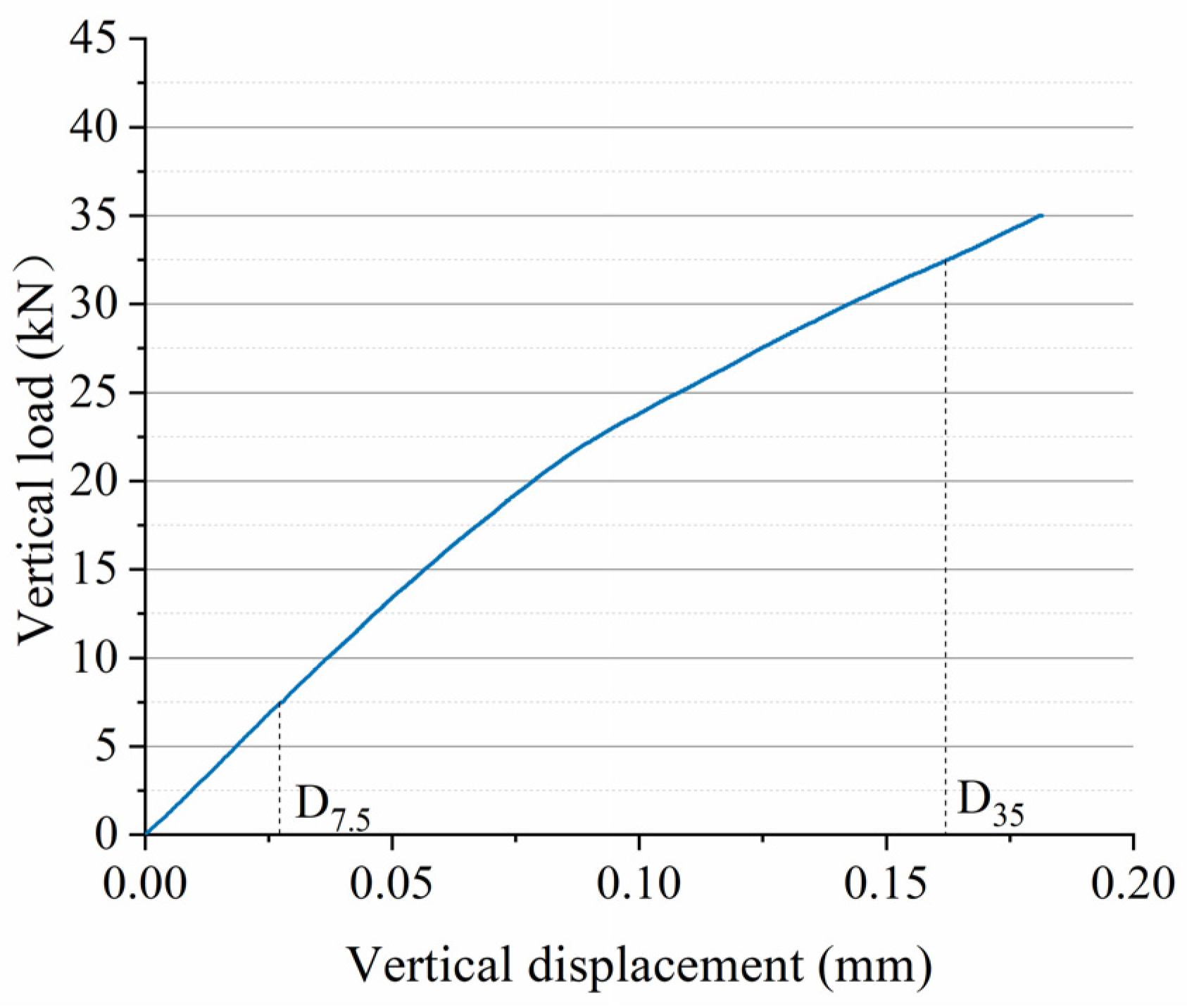
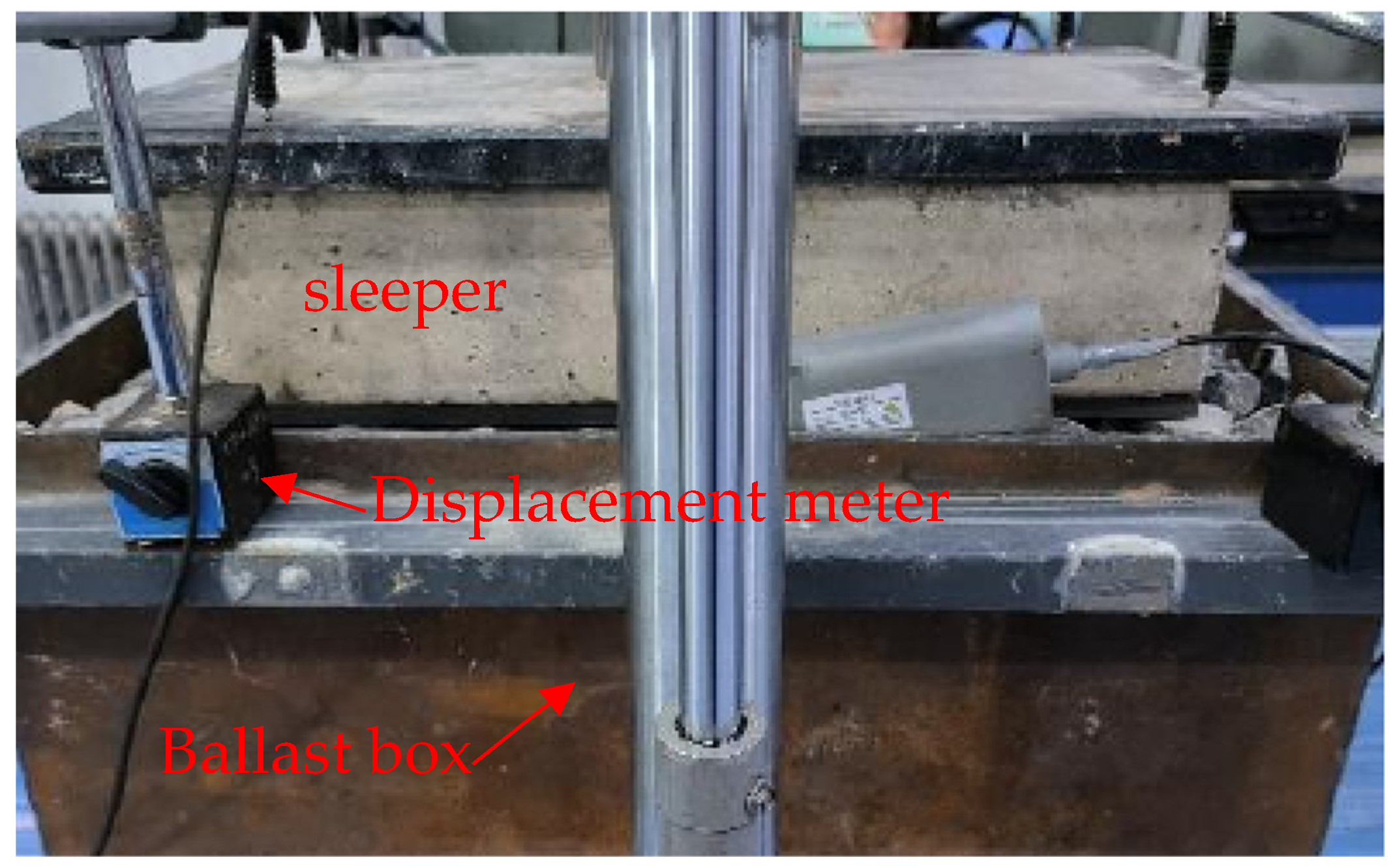

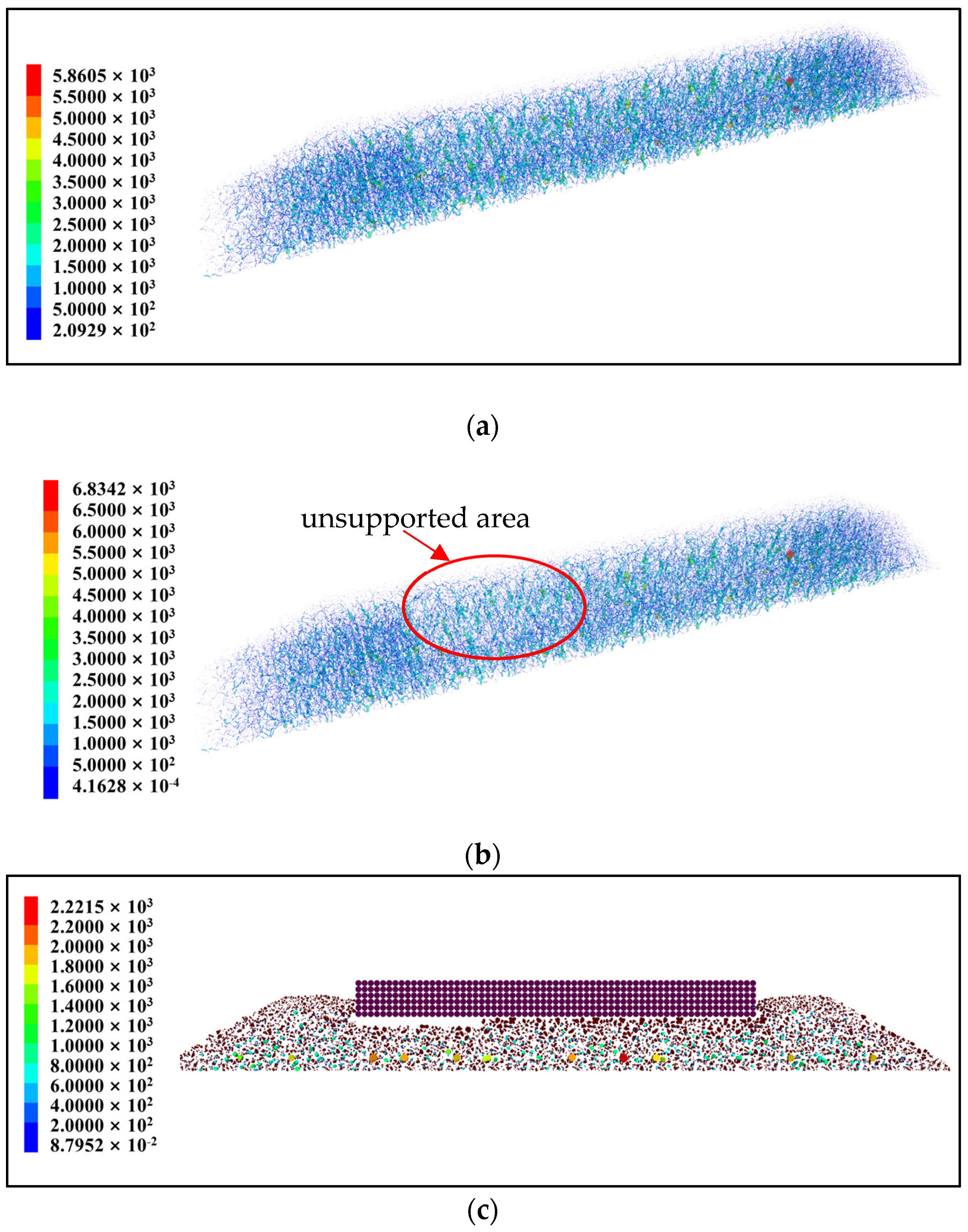

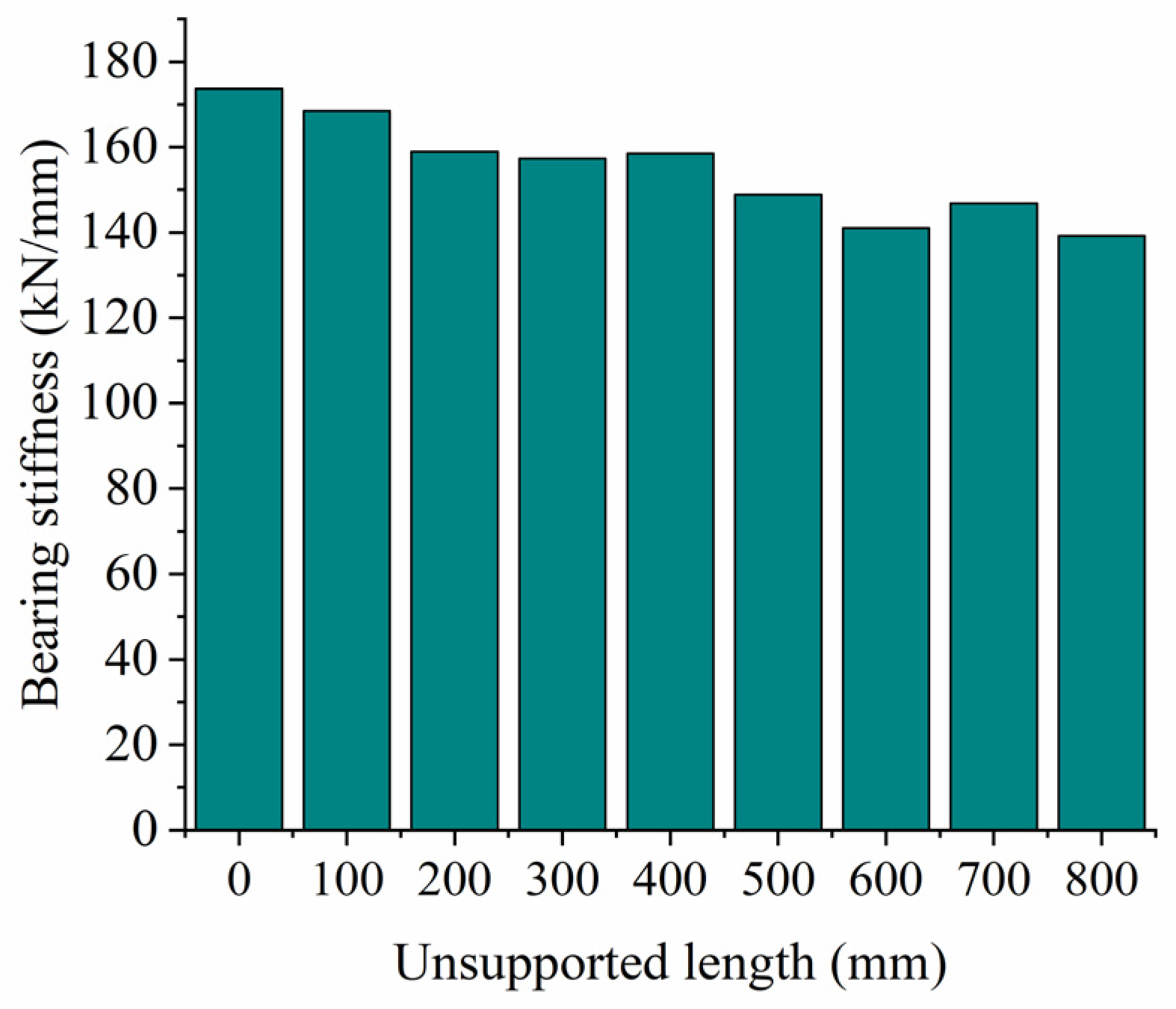
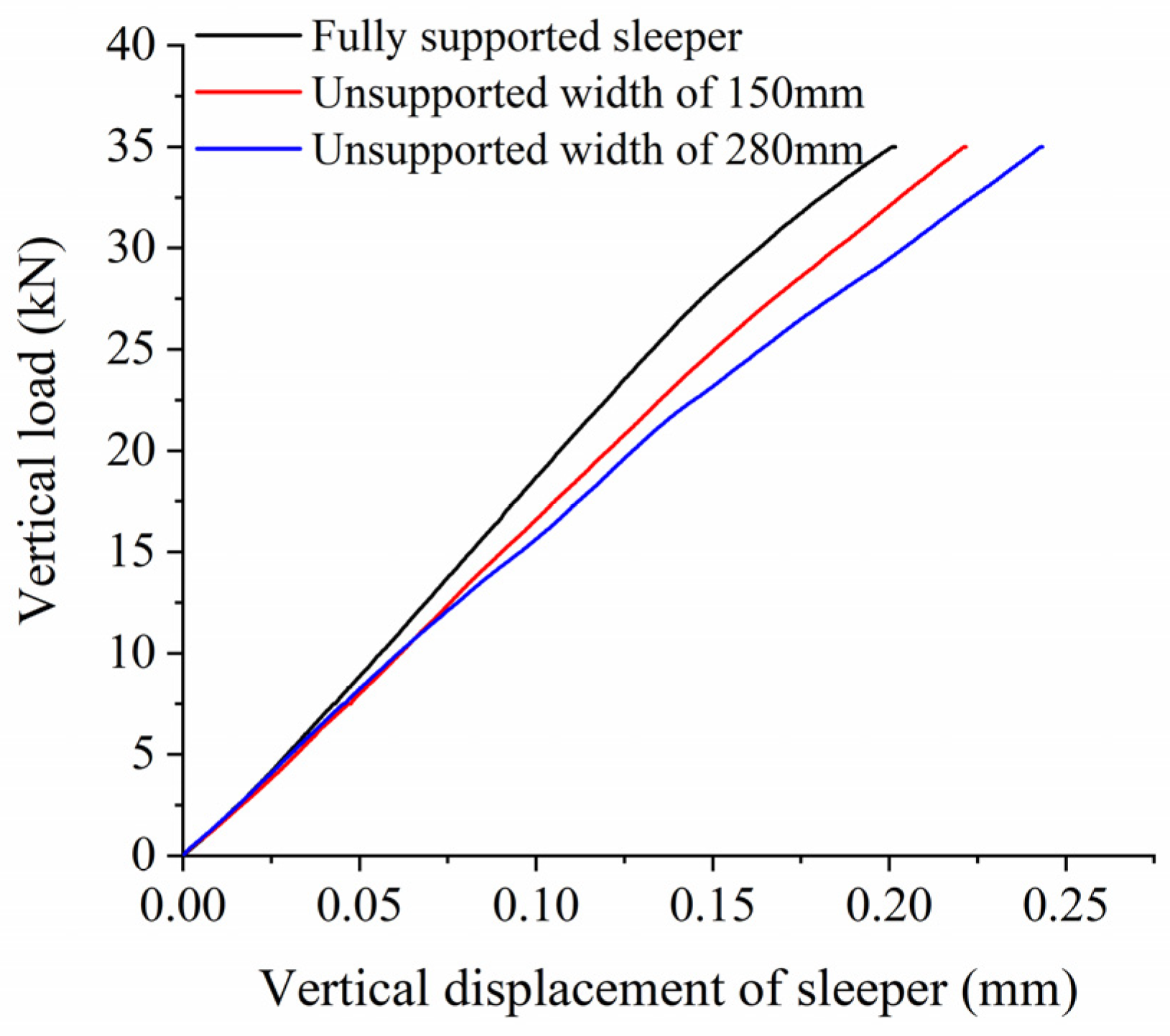
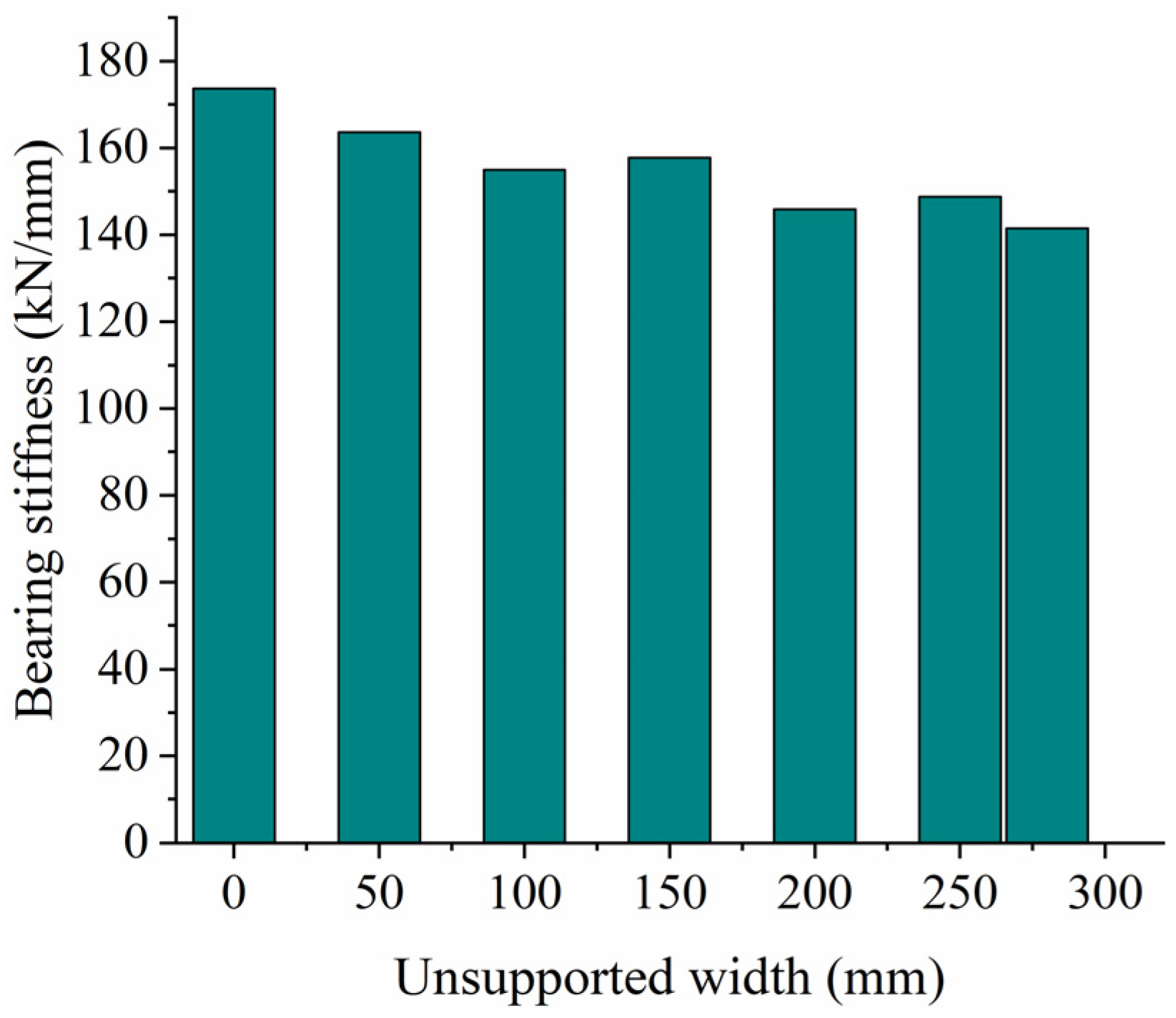
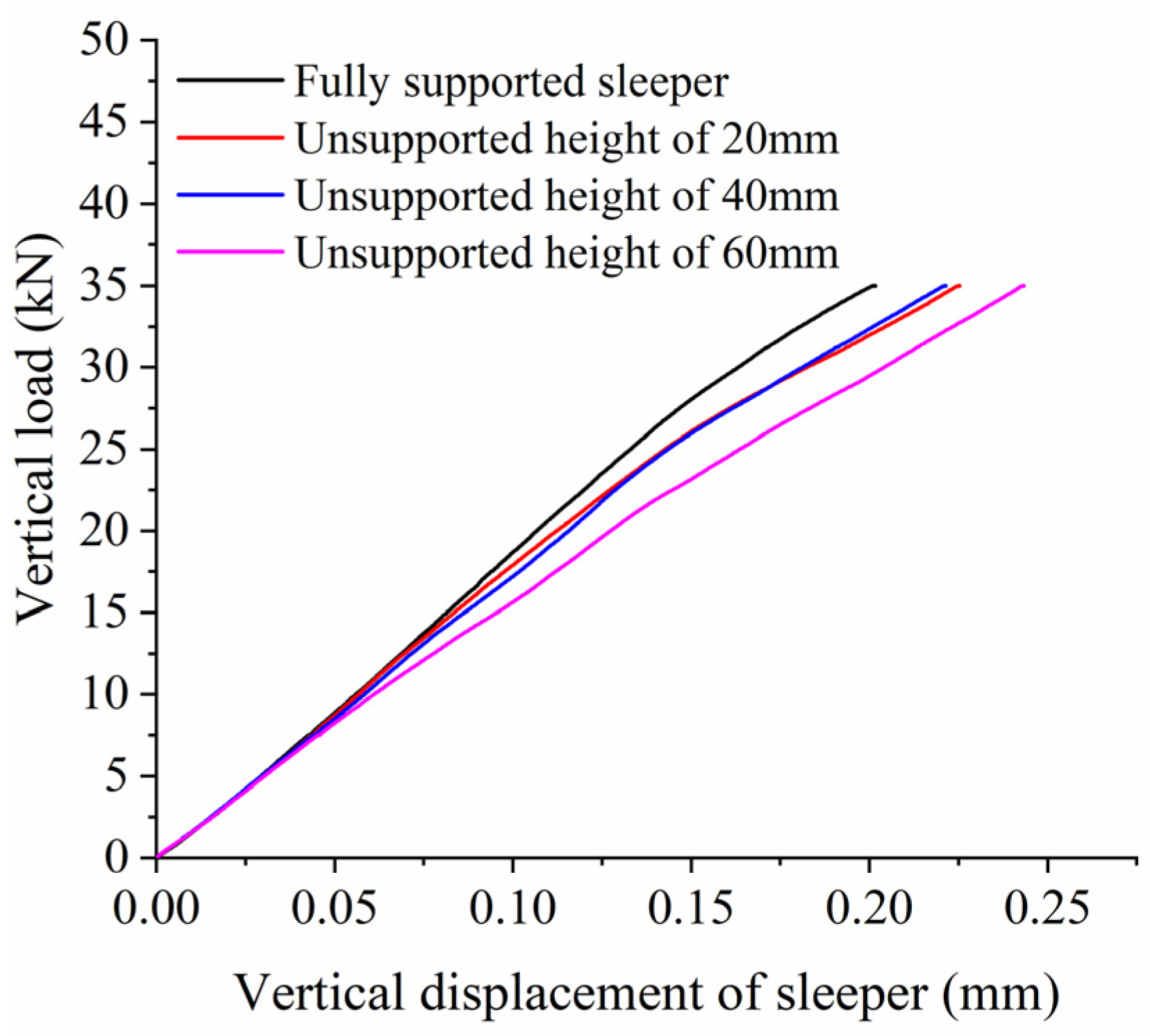
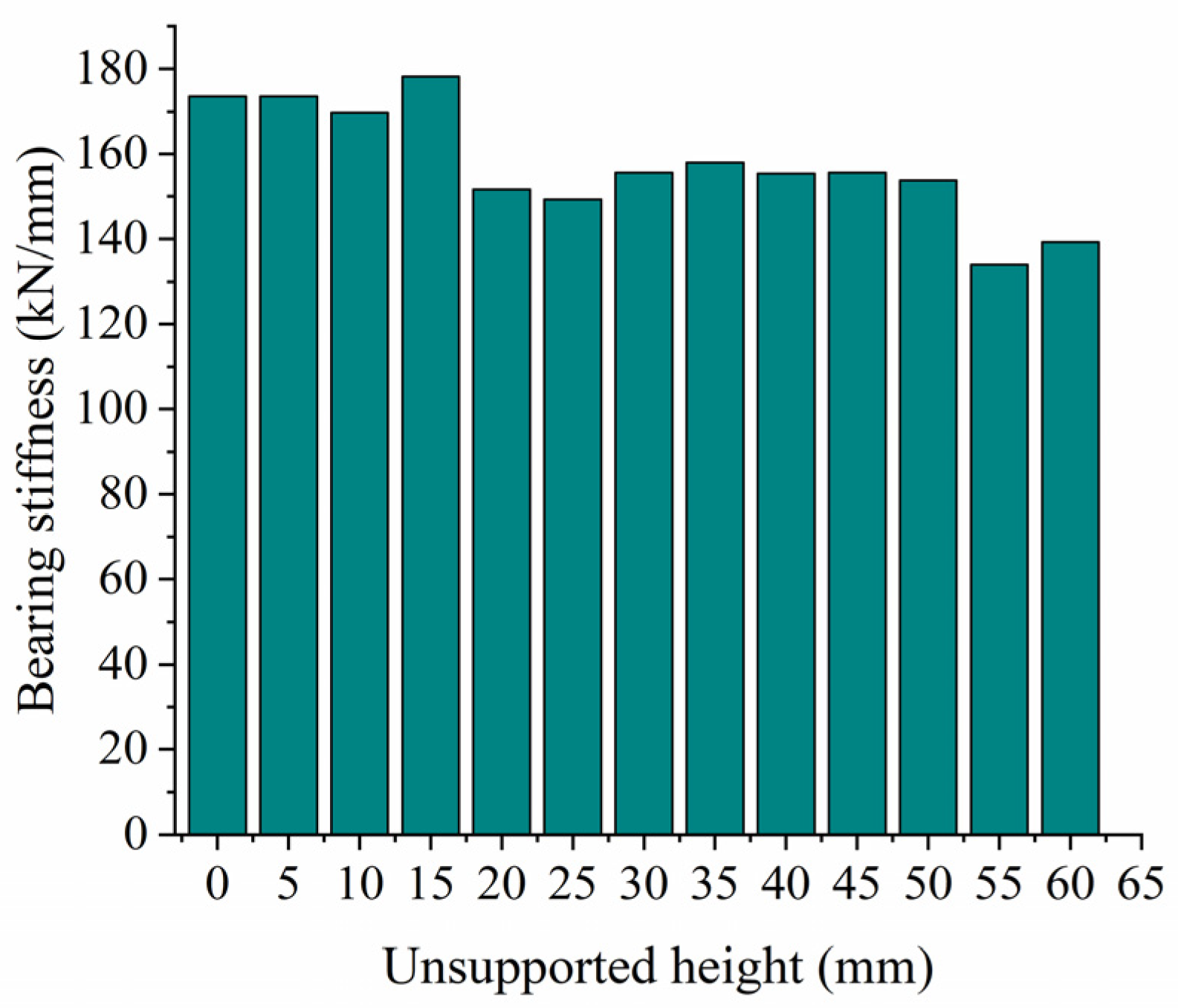


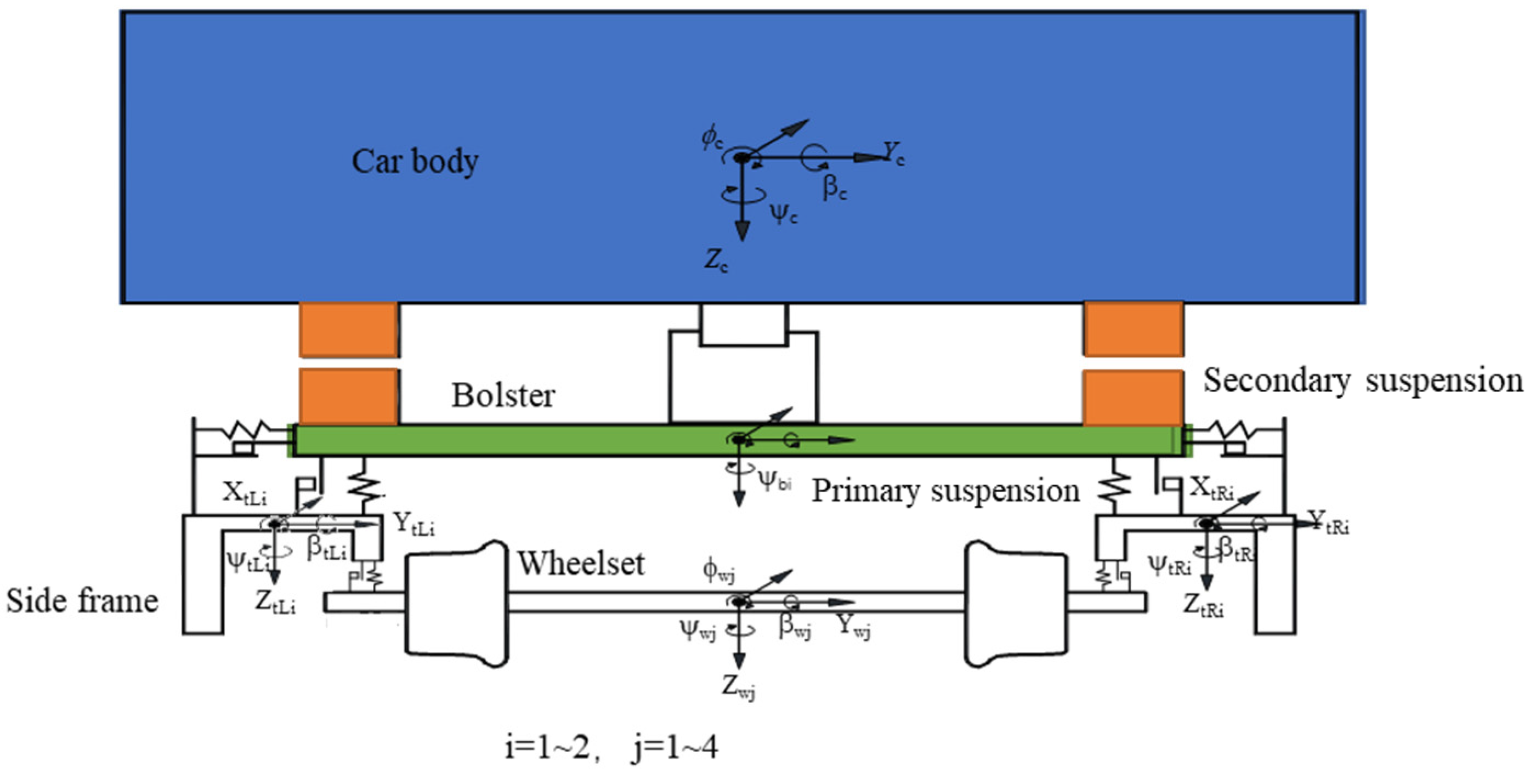
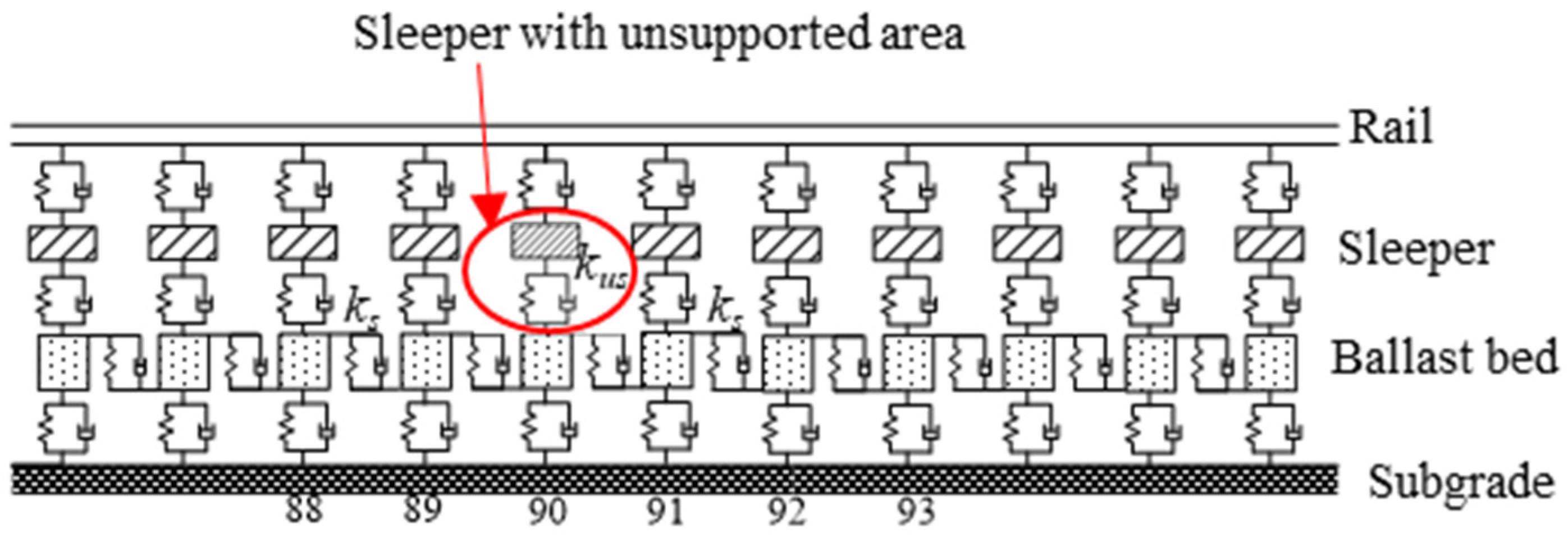

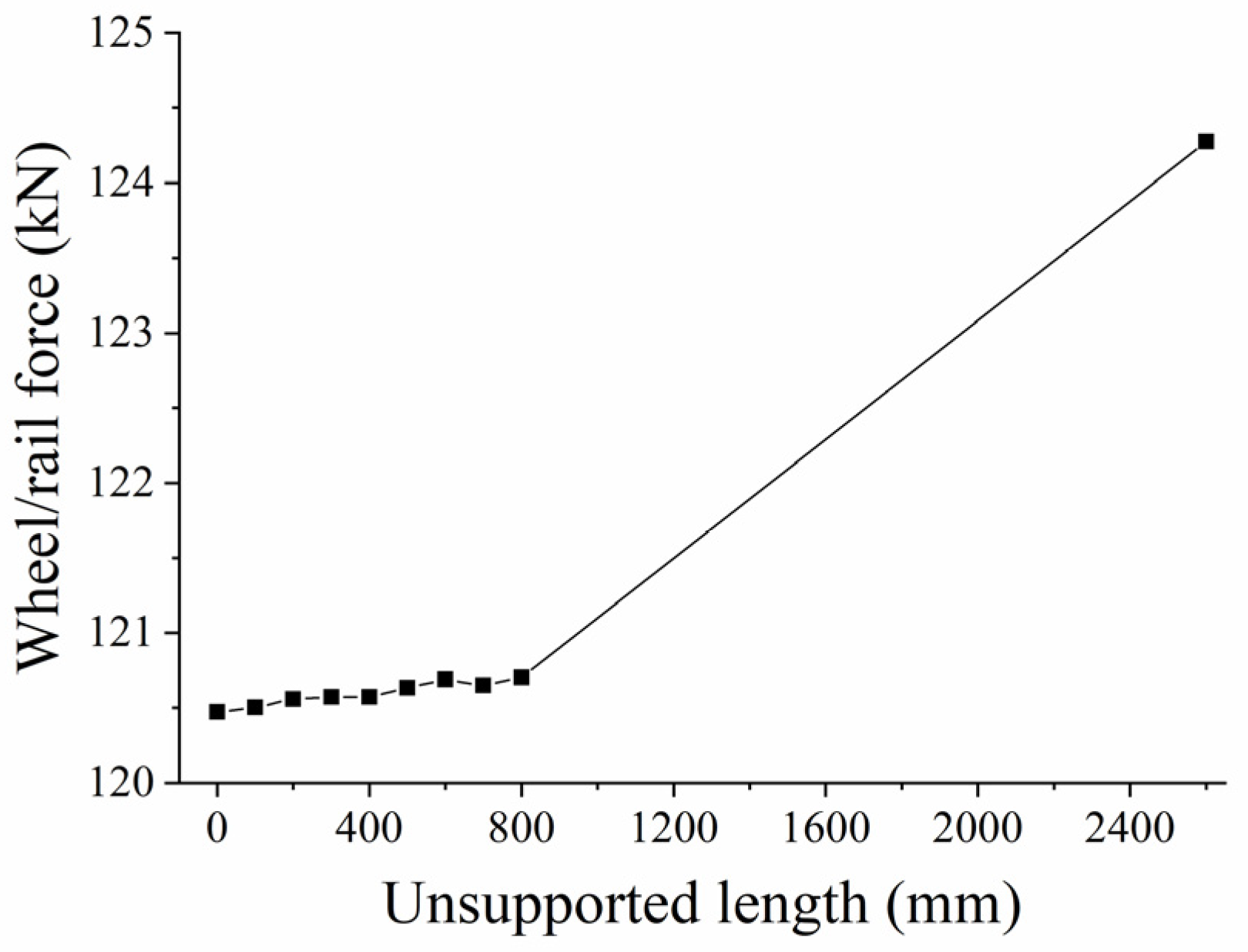




| No. | 1 | 2 | 3 | 4 | 5 |
|---|---|---|---|---|---|
| Shape |  |  |  | 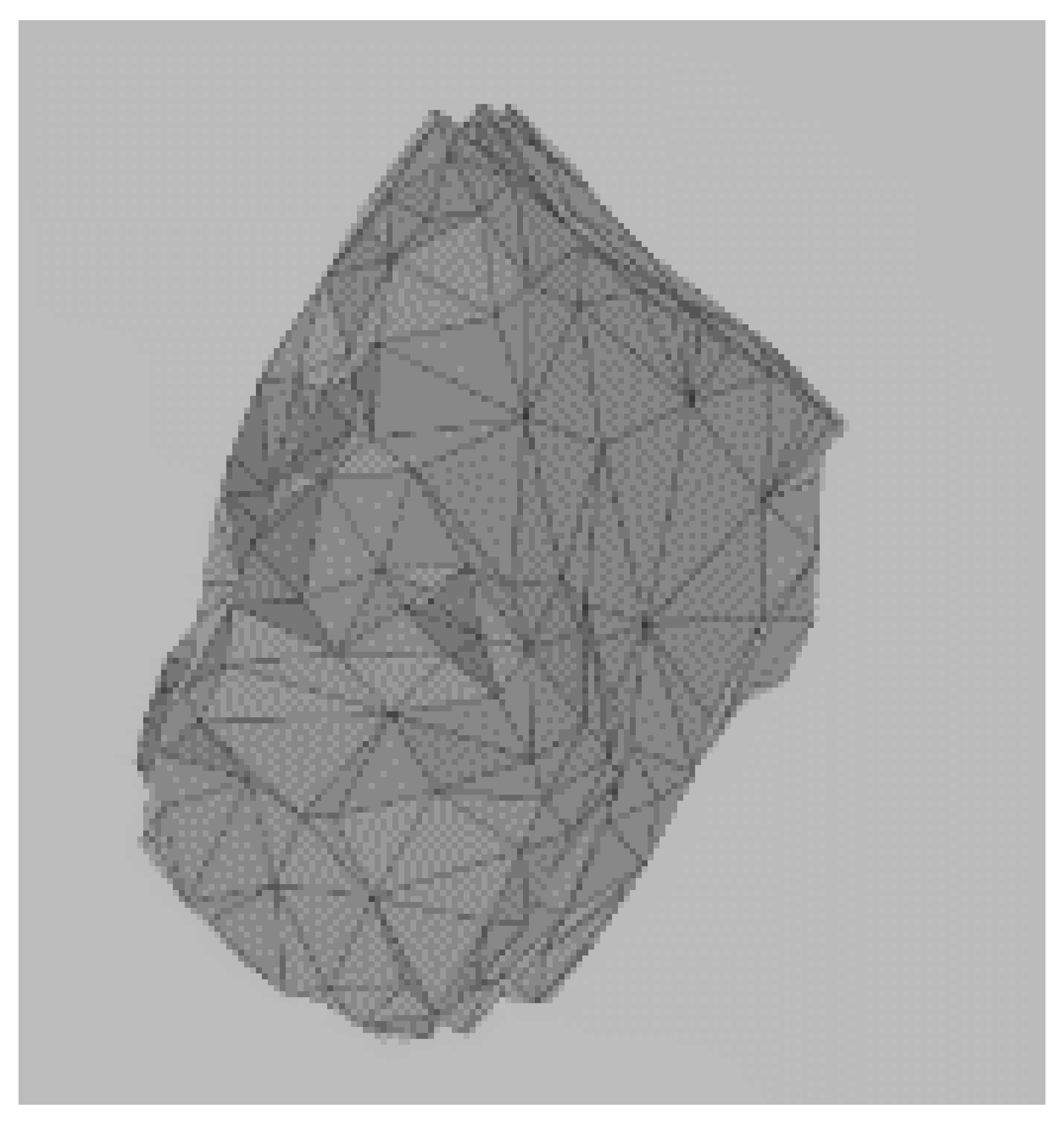 | 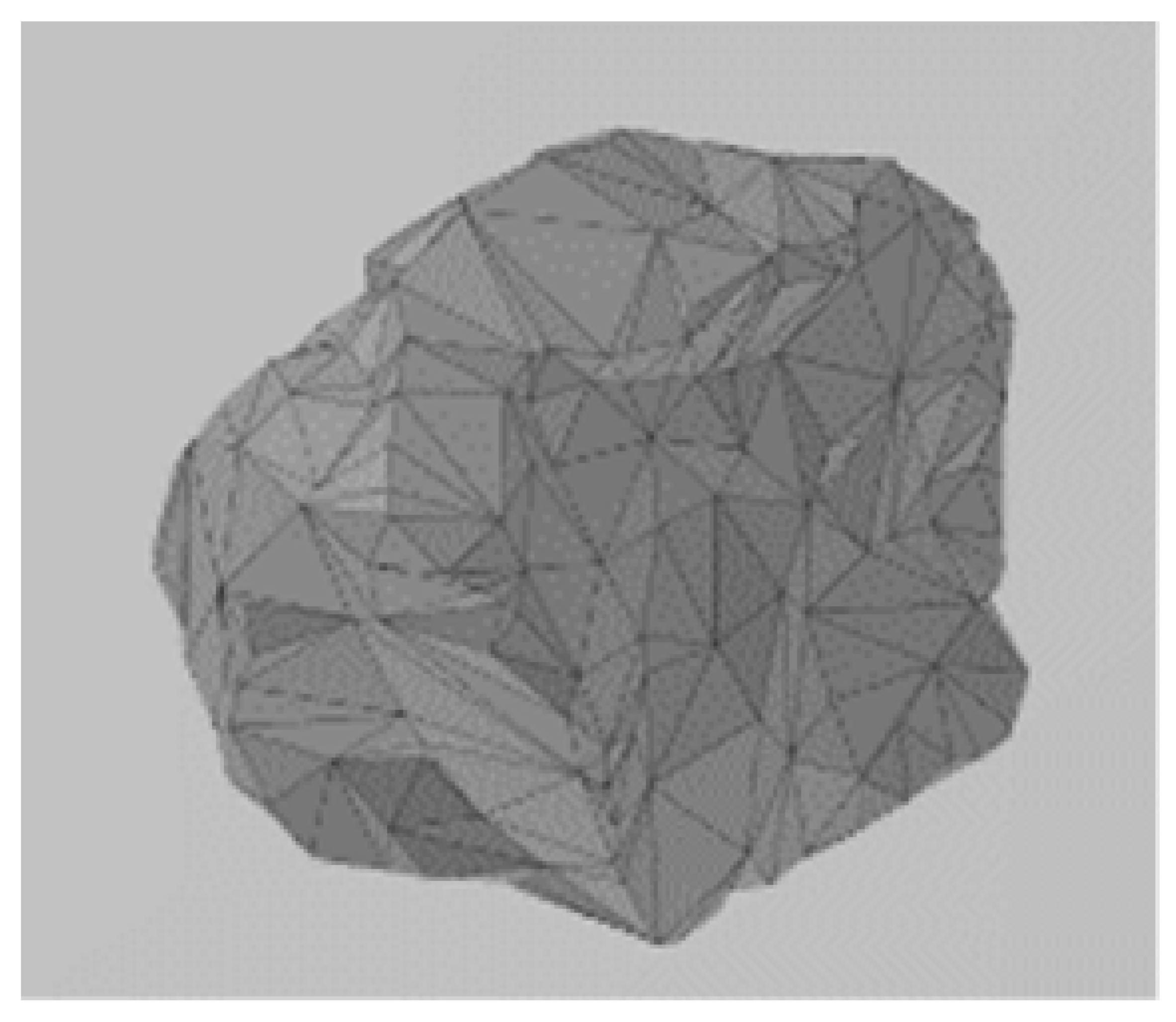 |
| Clump in DEM | 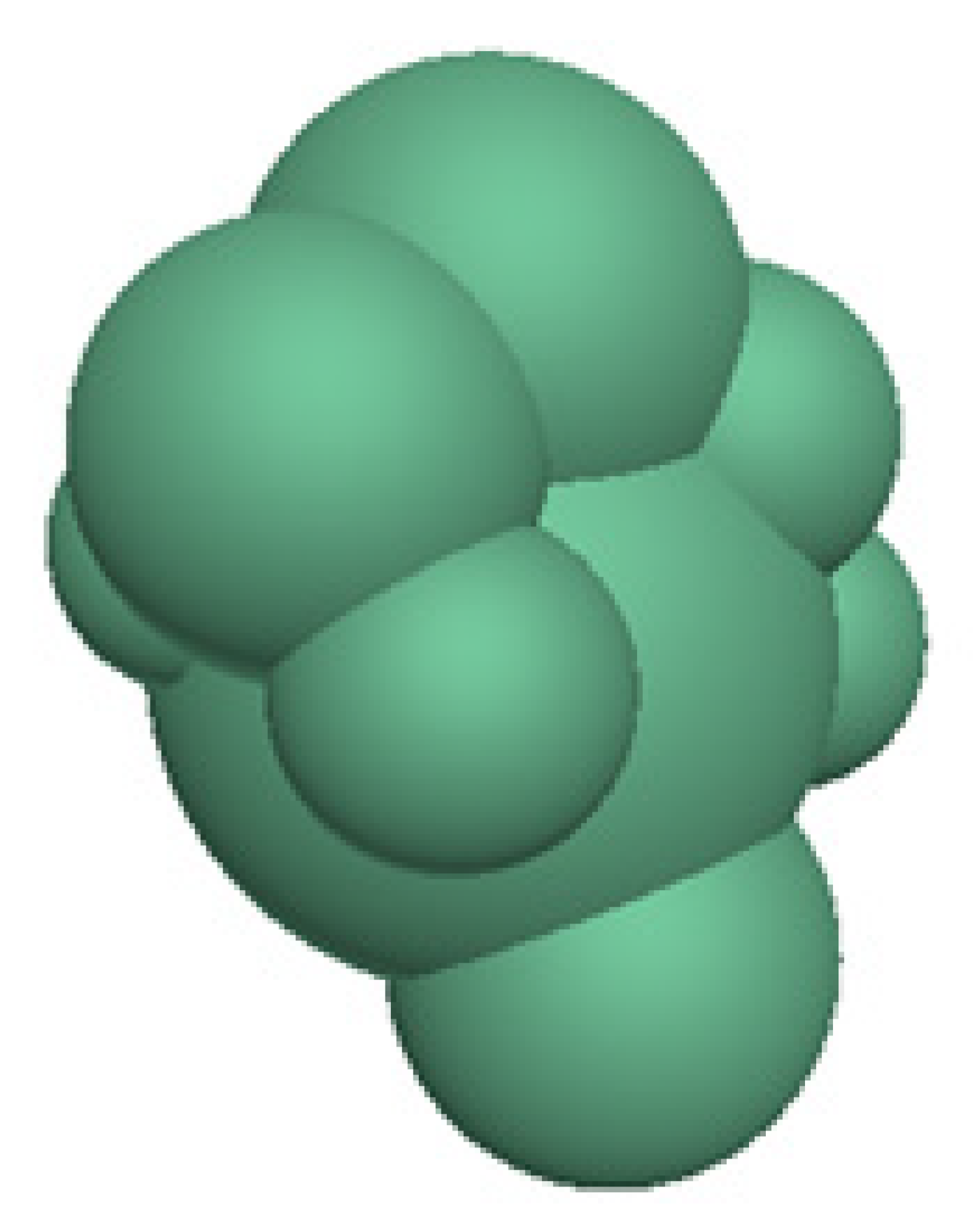 |  |  |  |  |
| Parameter | Value |
|---|---|
| Normal contact stiffness between ballast particle clumps/(N·m−1) | 1 × 108 |
| Shear contact stiffness between ballast particles/(N·m−1) | 1 × 108 |
| Normal contact stiffness between ballast and wall/(N·m−1) | 1 × 109 |
| Shear contact stiffness between ballast and wall/(N·m−1) | 1 × 109 |
| Friction coefficient of ballast particles | 0.55 |
| Coefficient of friction between ballast and wall | 0.5 |
| Density of ballast particles (kg·m−3) | 2600 |
| Experiment | Simulation | Difference | |
|---|---|---|---|
| Bearing stiffness/(kN·mm−1) | 184 | 173.63 | 6.1% |
| Parameter | Value |
|---|---|
| Car body mass (loaded)/kg | 91,838 |
| Mass of the bolster/kg | 745 |
| Mass of the side frame/kg | 497 |
| Wheelset mass/kg | 1171 |
| Stiffness coefficient of the primary suspension along the X-axis/(N·m−1) | 13 × 106 |
| Stiffness coefficient of the primary suspension along the Y-axis/(N·m−1) | 11 × 106 |
| Stiffness coefficient of the primary suspension along the Z-axis/(N·m−1) | 35 × 106 |
| Stiffness coefficient of the secondary suspension along the X-axis/(N·m−1) | 3.13 × 106 |
| Stiffness coefficient of the secondary suspension along the Y-axis/(N·m−1) | 3.13 × 106 |
| Stiffness coefficient of the secondary suspension along the Z-axis/(N·m−1) | 4.24 × 106 |
| Wheel radius/m | 0.42 |
| Rail mass per meter/kg | 74.4 |
| Sleeper mass/kg | 360 |
| Ballast mass/kg | 560 |
| Vertical pad stiffness/(N·m−1) | 120 × 106 |
| Vertical ballast stiffness/(N·m−1) | 100 × 106 |
| Vertical subgrade stiffness/(N·m−1) | 100 × 106 |
| Sleeper spacing/m | 0.6 |
| Gauge/m | 1.435 |
Disclaimer/Publisher’s Note: The statements, opinions and data contained in all publications are solely those of the individual author(s) and contributor(s) and not of MDPI and/or the editor(s). MDPI and/or the editor(s) disclaim responsibility for any injury to people or property resulting from any ideas, methods, instructions or products referred to in the content. |
© 2024 by the authors. Licensee MDPI, Basel, Switzerland. This article is an open access article distributed under the terms and conditions of the Creative Commons Attribution (CC BY) license (https://creativecommons.org/licenses/by/4.0/).
Share and Cite
Liu, D.; Su, C.; Zhang, D.; Lan, C. The Influence of an Unsupported Sleeper on the Vertical Bearing Characteristics of Heavy-Haul Railway Ballast. Materials 2024, 17, 1434. https://doi.org/10.3390/ma17061434
Liu D, Su C, Zhang D, Lan C. The Influence of an Unsupported Sleeper on the Vertical Bearing Characteristics of Heavy-Haul Railway Ballast. Materials. 2024; 17(6):1434. https://doi.org/10.3390/ma17061434
Chicago/Turabian StyleLiu, Dan, Chengguang Su, Dawei Zhang, and Caihao Lan. 2024. "The Influence of an Unsupported Sleeper on the Vertical Bearing Characteristics of Heavy-Haul Railway Ballast" Materials 17, no. 6: 1434. https://doi.org/10.3390/ma17061434






